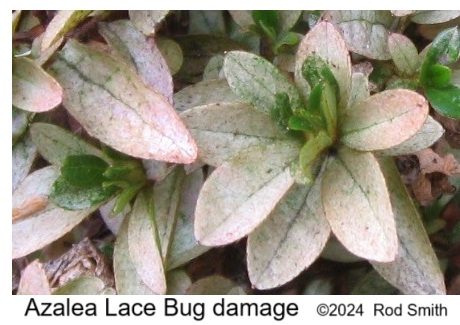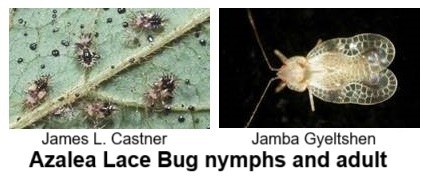|
|
|
The
 leaves of many azaleas have been bleached almost white starting in 2011. The tiny white spots on the leaves indicated
lace bug damage, but it was many times worse than I had ever seen before. This was because the Azalea Lace Bug had moved into the area.
leaves of many azaleas have been bleached almost white starting in 2011. The tiny white spots on the leaves indicated
lace bug damage, but it was many times worse than I had ever seen before. This was because the Azalea Lace Bug had moved into the area.
Azalea Lace Bug is very similar to Rhododendron Lace Bug, which has been here a long time. They both have flat, overlapping wings which are mostly transparent with dark markings. The nymphs hatch from eggs in the spring and begin to feed on the underside of the leaves. The dark spots on the leaves are varnish-like droppings. The biggest difference is that Azalea Lace Bug has three or four generations each year, so it multiplies faster and feeds longer than Rhododendron Lace Bug, which has only one generation each year. Most azaleas and many rhododendrons are seriously damaged by these lace bugs.
The leaves on this azalea stayed a healthy green in 2012 and 2013. The difference was a single spray each June with Cyfluthrin and Imidacloprid which are the active ingredient in BioAdvanced Complete Insect Killer. Cyfluthrin is a synthetic pyrethroid which acts quickly and controls many different kinds of insects. Imidacloprid is a long lasting neonicotinoid insecticide which protects the plant for the rest of the summer. It is also systemic which means it will absorb into the plant and move around to protect the undersides of leaves which did not get sprayed. It is most effective if sprayed when lace bugs first appear in late May or early June. However, it is toxic to bees, so it cannot be sprayed until plants have finished blooming. Sometimes I pull the last of the flowers off of the late blooming rhodies so I can spray all the rhodies and azaleas at the same time.
Unfortunately,
 Imidacloprid and Cyfluthrin are also toxic to beneficial insects which are natural predators of lace bugs: assassin bugs, lacewing larvae,
ladybird beetles, pirate bugs and predaceous mites. These help limit the numbers of lace bugs, but they will not eliminate them.
Imidacloprid and Cyfluthrin are also toxic to beneficial insects which are natural predators of lace bugs: assassin bugs, lacewing larvae,
ladybird beetles, pirate bugs and predaceous mites. These help limit the numbers of lace bugs, but they will not eliminate them.
Instead of spraying the leaves, another option is to drench the soil around the base of the azaleas and rhodies with a stronger mixture of imidacloprid. This soil drench has to be applied in early April because it takes several weeks to absorb into the plants. The big advantage of soil drenching is that all of the plant is protected from harmful insects but there much less effect on bees and beneficial insects.
Another insecticide which can be used is Captain Jack's Deadbug Brew, which contains Spinosad, an organic insecticide. It is very effective on lace bugs, but has minimal effect on many of the natural predators and beneficial insects. However, it is poisonous to bees, so it cannot be sprayed on plants while they are blooming.
The ideal solution for lace bug damage is to remove heavily damaged plants and replace them with azaleas and rhodies which are resistant to lace bugs. Unfortunately, I found lace bug damage on every variety of azalea and rhododendron, but some varieties were much less likely to have damage than others. The worst damage on rhodies was on Chinoides, Cilipinense, PJM, Scarlet Wonder, Unique and Vulcan. The least damage was on Anah Kruschke, Daphnoides, Jean Marie and Ramapo. I have some in my yard which have never been treated. So far, the damage is light and acceptable. Of the azaleas, Flame Creeper, Delaware Valley, Hahn's Red, Hino Crimson, Macrantha and Rosebud had the least damage. There were other varieties with little damage, but I could not positively identify them.
Yaku hybrid rhodies and other varieties with thick fuzz (indumentum) under the leaves are likely to have less damage. Azaleas reported to have less damage are Cavalier, Dawn, Elsie Lee, Red Wing and Salmon Pink. Some of the Encore Azaleas varieties are reported to be more resistant: Autumn Amethyst, Autumn Cheer, Autumn Rouge, Autumn Royalty, Autumn Sangria and Autumn Twist.
Pest Control
Planting a Vegetable Garden
Planting in Clay Soil
Preferred Soil pH
Pruning for Shade, Flowers and Fruit
No One Wins an Argument